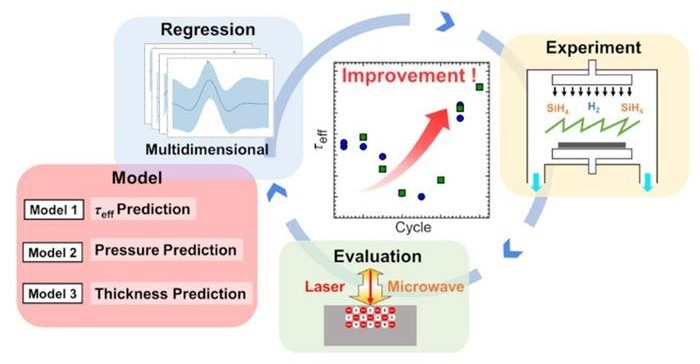Reviewed by Lexie CornerMar 6 2024
Amid the mounting threat of climate change, recent decades have seen significant advancements in solar energy technology. Silicon heterojunction (SHJ) solar cells, in particular, have garnered attention for their ability to achieve remarkably high energy conversion efficiencies.
 The proposed constrained BO technique combines different prediction models to ensure that the suggested deposition conditions are feasible and that the thickness of the passivation film stays within acceptable limits. By iteratively manufacturing, evaluating, and feeding the measured data back to the models, this implementation of BO quickly leads to deposition conditions that produce exceptional thin passivation films. Image Credit: Keisuke Ohdaira from Japan Advanced Institute of Science and Technology.
The proposed constrained BO technique combines different prediction models to ensure that the suggested deposition conditions are feasible and that the thickness of the passivation film stays within acceptable limits. By iteratively manufacturing, evaluating, and feeding the measured data back to the models, this implementation of BO quickly leads to deposition conditions that produce exceptional thin passivation films. Image Credit: Keisuke Ohdaira from Japan Advanced Institute of Science and Technology.
The effectiveness of SHJ solar cells is largely determined by the quality of their passivation layer. This thin film, composed of intrinsic hydrogenated amorphous silicon (i-a-Si:H), plays a crucial role in preventing the loss of light-excited charge carriers, such as electrons, through recombination.
Scientists from the Japan Advanced Institute of Science and Technology (JAIST) have recently explored catalytic chemical vapor deposition (Cat-CVD) to develop thin passivation films on SHJ solar cells.
In general, Cat-CVD stands out as an appealing and highly effective method for depositing films without causing damage to the substrate, unlike plasma-based deposition techniques. However, identifying the ideal deposition conditions for producing superior-quality i-a-Si:H films has proven challenging. This difficulty arises from Cat-CVD's numerous modifiable parameters, such as gas flow rates, substrate temperature, and deposition time. Consequently, determining the ideal combination via trial and error is exceedingly laborious.
In a new study reported online on February 8th, 2024, and published in the journal ACS Applied Materials and Interfaces on February 21st, 2024, a team of researchers headed by Professor Keisuke Ohdaira from JAIST formulated a ground-breaking and efficient approach to achieve the ideal deposition conditions for Cat-CVD.
This study was co-authored by Master’s student Ryota Ohashi, Research Assistant Professor Huynh Thi Cam Tu, and Koichi Higashimine, a senior technical specialist from JAIST, together with Dr. Kentaro Kutsukake, a scientist at RIKEN.
The strategy proposed in this study is grounded in the practical application of an optimization method called Bayesian Optimization (BO). This widely used approach, which depends on machine learning, is employed to identify the maxima of a function with an unknown shape.
In the context of Cat-CVD, BO refers to a sequential process in which a set of known deposition circumstances and their related output are fed into an algorithm, which then predicts the output for deposition conditions yet to be assessed. The algorithm finally determines the optimum values after repeatedly testing projected deposition circumstances and returning the results.
However, applying BO to the Cat-CVD problem is not straightforward.
In simple Bayesian optimization, aimed solely at maximizing carrier lifetime, there are no functions to regulate the thickness of the film suggested for the next experimental conditions, leading to thick films that may cause operational problems. Additionally, the experimental conditions suggested may result in combinations that are not feasible, such as mismatches between gas flow rate and the exhaust capacity of the film deposition equipment.
Keisuke Ohdaira, Professor, Japan Advanced Institute of Science and Technology
To address these challenges, the team applied a practical optimization system called “constrained BO.” In this system, they integrated three diverse prediction models. The first model predicted the performance of the deposited film with regard to the charge carrier lifetime.
The second model projected the deposition pressure based on the input gas flow rates, eliminating impractical or unattainable deposition conditions. The third model constrained the film’s thickness while accounting for deposition time, a crucial parameter in Cat-CVD.
After inputting their integrated model with 14 primary samples (with regard to deposition conditions and experimentally measured film performances), the team only needed to conduct eight cycles of optimization to achieve high carrier lifetimes. Complete optimization was realized after twenty cycles. Remarkably, the suggestions of the model enabled the researchers to discover formerly unknown parameter combinations that resulted in high carrier lifetimes.
By varying multiple film deposition parameters according to the suggestions of constrained Bayesian optimization, we found that the combination of substrate temperature during film deposition and the flow rate of the precursor gas SiH4 is crucial for achieving strong ability to suppress carrier recombination. Constrained Bayesian optimization, thus, provides not only optimal deposition conditions but also scientific knowledge.
Keisuke Ohdaira, Professor, Japan Advanced Institute of Science and Technology
The findings of this study highlight the potential of constrained BO not only for the development of high-performance solar cells but also for a wide range of devices.
“The proposed approach should be applicable across a wide range of fields for the practical optimization of complicated material processes, including film deposition, which is fundamental in the manufacture of most electronic devices,” Ohdaira noted.
Hopefully, these initiatives will help realize BO’s full potential and open the door to more productive industrial techniques and environmentally friendly energy sources.
Journal Reference:
Ohashi, R., et al. (2024) High Passivation Performance of Cat-CVD i-a-Si:H Derived from Bayesian Optimization with Practical Constraints. ACS Applied Materials and Interfaces. doi:10.1021/acsami.3c16202.